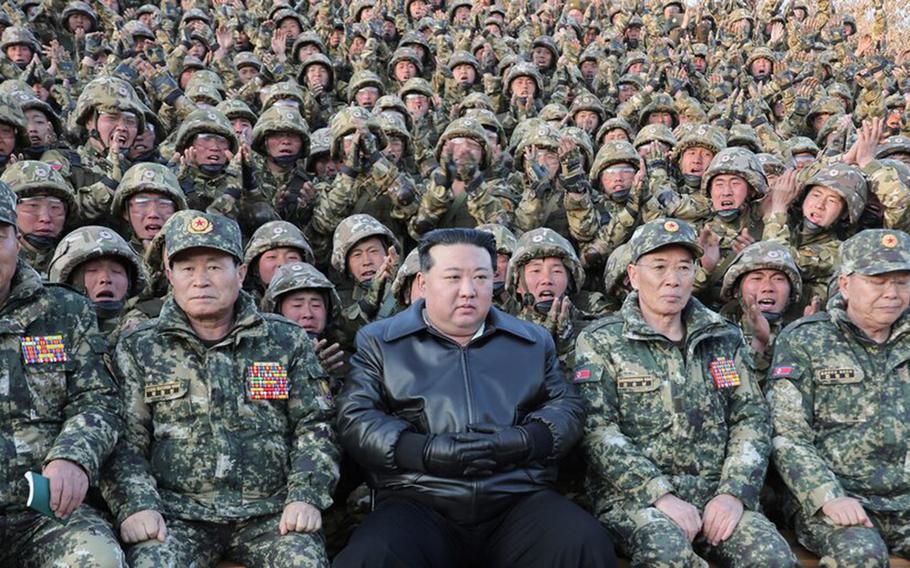
North Korean leader Kim Jong Un poses with troops in this image released by the state-run Korean Central News Agency, March 7, 2024. (KCNA)
Considerable media attention is directed to reports that North Korea is supplying troops to aid Russia’s war in Ukraine along with workers. In reality, this is simply the latest step closer between two already-close but weak partners.
Both struggle today. Moscow’s assumption that Ukraine would be an easy conquest has proven disastrously wrong. As the war grinds on, significant numbers of young men are fleeing Russia rather than being drafted into the military.
Undeniably also, North Korea is in desperate economic difficulty. The COVID-19 pandemic brought the nation’s long-apparent economic deterioration into a severe decline. Trade and wider interchange with China has contracted, while long-term economic sanctions under the United Nations slowly strangle commerce.
Belligerence remains the default Pyongyang position. During 2024, North Korea continued to enhance and develop the nation’s ambitious missile program. North Korea has tested intercontinental ballistic missiles capable of reaching the United States. Last December, there was a test of the solid-fuel Hwasong-18, the nation’s most advanced such missile.
Meanwhile, on Aug. 1 the biennial Rim of the Pacific (RIMPAC) concluded. This is the world’s largest maritime military exercise involving extensive combined arms training. Approximately 25,000 personnel and 29 nations in total participated, including Japan, South Korea and the United States. This represents a strong military security mechanism for potential defense of South Korea and other Asia allies.
As argued in previous columns, the basic strategic realities in North Korea are unchanging. First, for many years Pyongyang has been inconsistent, often erratically. In 2013, the regime declared a “state of war” with South Korea and abruptly abrogated the 1953 armistice that ended the Korean War. Yet, accommodating moves followed. President Donald Trump conducted highly publicized meetings with Kim Jong Un, though nothing was achieved.
Second, we must emphasize defense of South Korea, within wider Asia security. The Biden administration is doing precisely this with extensive Asia trips by President Joe Biden and other senior administration officials.
Third, we should emphasize coordination with other nations. In 2017, Japan reenergized fitful security discussions, including Australia, India and the United States. Dubbed the Quad, this security dialogue is important.
Secretary of Defense Lloyd Austin has emerged as a visible official of the Biden administration addressing international threats. He has proven to be judicious, restrained and also effective in projecting an image of leadership and strength, avoiding emphasis on our military capacity that is already self-evident.
South Korea’s substantial investment in and trade with China grows, while North Korea remains a costly dependent, though ideologically important. China President Xi Jinping visited Seoul in 2014. He finally visited North Korea in 2019.
China’s foreign policy reflects self-interest, and traditional caution regarding military force. North Korea is a drain, and over time a source of growing well-founded anxiety.
The brutal Korean War of 1950 to 1953 is essential background. President Harry Truman decided to support the United Nations’ defense against Pyongyang’s invasion of South Korea.
President Dwight Eisenhower quickly achieved an armistice in the Korean War. A crucial factor was devastating unrestrained bombing of North Korea. Pyongyang’s hostility today reflects this frightening history.
Democratic change culminated with election in 1998 of President Kim Dae-jung, heroic opponent of dictatorship. In 2000, he received the Nobel Peace Prize. During the earlier dictatorship, Kim Dae-jung survived imprisonment and at least one attempt to kill him. Periodic turmoil since 1998 has reinforced South Korea democracy.
U.S. leaders currently emphasize collaboration with allies, including South Korea. The Biden administration returned to emphasis on working with our principal allies. Our power dwarfs that of Russia and North Korea.
Powerful ties with South Korea from the Korean War, greatly reinforced during the Vietnam War, is a lynchpin.
We hold the high ground.
Arthur I. Cyr is author of “After the Cold War – American Foreign Policy, Europe and Asia.”